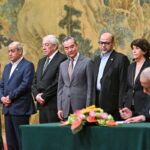A range of high-level interactions since June seem to herald a new balance in the much-troubled Sino-US relations. While a major détente between the two powers still seems unlikely at this stage, the free-falling bilateral relationship that was witnessed in the previous two years has shown signs of stabilisation. An immediate escalation into a disastrous confrontation is likely averted for the time being. What is unique in this new balance is that the temporary respite does not come from the reduction of pressure from either side, but rather from diplomatic engagement that soothes the anxieties of the parties concerned.
To be sure, the Biden Administration has only increased its measures to moderate China’s momentum this year. Militarily, the US reached a deal with the Philippines, granting four American bases in the country, including some close to Taiwan and the South China Sea. Additionally, the AUKUS project to assist Australia with nuclear submarine construction was also targeted at China’s influence in the Indo-Pacific region. Moreover, the US unveiled its military aid to Taiwan, worth $345 million, a move that certainly would anger China. On the side of technology, the US, Japan and the Netherlands reached an agreement to restrict China’s access to chip-manufacturing equipment , hoping to dent China’s effort to build its own advanced chips. Diplomatically, the leaders of the US, Japan and South Korea promised to bring trilateral security cooperation to new heights, and they jointly defined China’s claim in the South China Sea as “unlawful”. Lastly, the US successfully pushed for an upgrade in its relationship with Vietnam, which included rare earth mining that diversifies US reliance on China. All these events happened with the US imposing rounds of sanctions on China, which have added to the difficulty of lifting up Beijing’s struggling economy. According to China’s Ambassador to the US Xie Feng, “over 1,300 Chinese entities and individuals are on US sanction lists. As a result, many Chinese workers have been forced out of job, and their families suffered greatly.”
China is not a power without ambitions. Its Global Security Initiative and the Global Civilisation Initiative, plus its most recent Proposal of the People’s Republic of China on the Reform and Development of Global Governance, aim at altering the current global order dominated by the West. Nevertheless, time may not necessarily be on its side. One prominent Chinese economist estimates that it could take a decade for China to fix intractable problems in the real estate sector, which is a significant part of its economy. Another factor that could hamper China’s long-term competence is its declining population. With a lessened population, there could be a decrease in demand for goods and services, which would negatively impact businesses and economic growth. Taiwan’s opposition party KMT, which historically endorsed unification with China, used to be in Beijing’s favour for many years, but a recent speech from its presidential candidate for the next election has called for a strong military to “deter aggression”. The latest political trend in the self-ruling island would undoubtedly lessen the prospect of a “peaceful unification” preferred by Beijing.
As a result, whether China’s ambitious goals will draw near or float away in the long run is undecided. Given the unquestionable irritation and uncertainty China has at the moment, there tends to be an increasing incentive for a strategic showdown with the US, which China sees as the largest barrier on its path to rejuvenation. After all, former Chinese leader Deng Xiaoping’s strategy of “keep a low profile and bide your time” relies on two implicit conditions. First, the low-profile can be exchanged for a friendly international environment. Second, there should be a robust anticipation that the Chinese economy will grow at a satisfying rate. Neither condition holds at present, but it is noticeable that China still refrains from taking adventurist actions that would cross Washington’s line. First, to date, China has not provided direct military support for Russia’s war against Ukraine. Secondly, China has not conducted military campaigns over disputed territories, particularly those in the South China Sea and Taiwan. On the contrary, China is busy with diplomatic interactions with Washington in order to stabilise the bilateral relationship, at least temporarily.
In June, Antony Blinken became the highest US official to visit China in five years. Even though details of the talks were undisclosed, both sides agreed that progress had been made on specific issues. It turned out that Blinken’s trip was only the start to a series of high-level engagements. The following month saw another two US high-ranking officials paying visits to China. Treasury Secretary Janet Yellen concluded her trip with her satisfaction that the visit established person-to-person relationships with her Chinese counterparts and opened the door for more frequent contacts at the staff level. Buidling on her visit, the US and China launched two working groups focussing on economic and financial issues. While John Kerry, although immediate progress was less explicit during his visit, restarted the suspended climate dialogue between the US and China, the two largest carbon emitters in the world. Last year, due to China’s anger over then US House Speaker Nancy Pelosi’s visit to Taiwan, China cut off bilateral talks with the US on climate change. Kerry’s visit shows that China and the US have the willingness to turn the page on last year’s diplomatic row. In August, US Commerce Secretary Gina Raimondo’s visit to Beijing also led to something tangible: the US and China would establish a working group between the commerce departments — meet twice a year at the vice minister level and once at the minister level. In addition, Chinese Foreign Minister Wang Yi met with White House National Security Advisor Jake Sullivan in Malta in September. It was reported that the two sides had “candid, substantive and constructive” talks. Also in September, Blinken met with Chinese Vice President Han Zheng in New York City on the sidelines of the UN General Assembly.
What explains the intensive high-level interactions between China and the United States? Several key factors could account for it. First, although the US shows no sign of easing its sanctions on the Chinese economy, channels of communication are useful for clarifying intentions and prospects. In this sense, the US will be telling China that it takes little interest in a full decoupling from the Chinese economy as long as national security issues are addressed. This should assure China that except for a delineated area, the broader Chinese economy will not be hit by US sanctions. In turn, the US very much hopes to secure China’s restraint on the Russia-Ukraine conflict, particularly when the war is at a critical stage.
But then, what is behind China’s interest in these recent intensive diplomatic engagements? As has been discussed, playing a long game may not necessarily favour its ambitious blueprints for the world. Fundamentally, the diplomatic space for China to build its counterweight to the Western bloc remains open, allowing China to push for a multipolar world without an immediate breakup with the West. In March, China brokered a diplomatic breakthrough between Iran and Saudi Arabia, something that significantly increased China’s role as an international mediator and its influence in the region. On top of that, without Russia’s presence, China held a Summit with central Asian countries where it pushed for deeper cooperation with five countries that historically belonged to the Russian sphere of influence. Finally, the recent expansion of BRICS to include six new members could give China more diplomatic leverage in its rivalry with the US. All these moves suggest that despite immense pressure from the US, China may still feel that its global ambition is not stifled. In this case, to interact with Washington will hopefully delay further US-initiated acts of containment. In turn, this could buy China more time to get the economy back on its feet after last year’s stringent covid control.
It remains to be seen whether the US’ enthusiasm for interaction with China will continue after the Russia-Ukraine war. But at the moment, the US’ anxiety about China further leaning towards Russia and China’s anxiety about the US drastically ramping up sanctions have been alleviated by the frequent high-ranking engagements. It should be noted that actions from both sides to check the other will certainly continue in the foreseeable future. The new balance has been, and will remain to be, about managing confrontations and reducing misperceptions that could lead things out of control.
Source : E-InternationalRelations
















